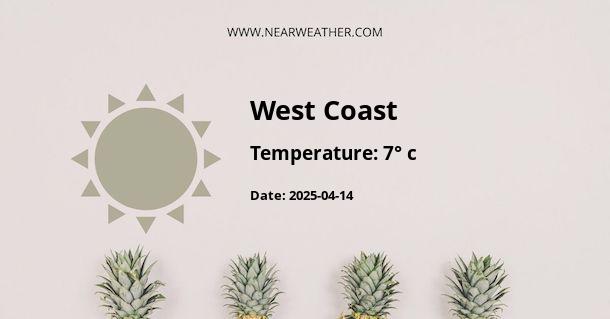Climate and Weather on the West Coast, Australia
Australia's West Coast is known for its stunning landscapes, beautiful beaches, and diverse wildlife. The region experiences a Mediterranean climate characterized by hot, dry summers and mild, wet winters. With a range of unique microclimates and diverse weather patterns, the West Coast offers a variety of experiences for both locals and visitors throughout the year.
Seasonal Overview
Let's explore the weather patterns on the West Coast throughout the year:
Summer (December to February)
Summers on the West Coast are typically hot and dry, with average temperatures ranging from 25°C to 35°C (77°F to 95°F). The coastal areas experience cooling sea breezes, providing relief from the intense heat. However, inland areas can be significantly warmer. This season is ideal for beach activities, water sports, and exploring the region's stunning natural attractions.
Autumn (March to May)
Autumn brings milder temperatures and the occasional rainfall to the West Coast. Average temperatures range from 15°C to 25°C (59°F to 77°F). The weather is pleasant, making it a great time for hiking, wildlife spotting, and visiting vineyards in the renowned wine regions of Margaret River and Swan Valley.
Winter (June to August)
Winters on the West Coast are mild and relatively wet. Average temperatures range from 10°C to 20°C (50°F to 68°F). The region experiences occasional rainfall and strong winds, especially along the coast. Winter is an excellent time for whale watching as southern right and humpback whales migrate along the coastline.
Spring (September to November)
Spring brings mild temperatures and blooming wildflowers to the West Coast. Average temperatures range from 15°C to 25°C (59°F to 77°F). With the countryside awash in vibrant colors, this season offers fantastic opportunities for nature walks, birdwatching, and outdoor events like wildflower festivals.
Precipitation
The West Coast experiences its highest rainfall during the winter months, particularly from June to August. The coastal areas receive around 800mm (31 inches) of rainfall annually, while inland regions may receive slightly less. The precipitation contributes to the fertility of the region's agricultural land and supports the growth of diverse flora and fauna.
Unique Weather Phenomena
The West Coast is known for its occasional weather phenomena, including the famous "Fremantle Doctor," a cooling afternoon sea breeze that provides relief from the summer heat. Additionally, the region may experience brief but intense thunderstorms during the summer months, adding to the dramatic display of nature's forces.
Cyclones and Extreme Weather
While the West Coast is generally sheltered from tropical cyclones that affect northern parts of Australia, the region can experience occasional winter storms with strong winds and heavy rainfall. These events are closely monitored, and appropriate warnings are issued to ensure the safety of residents and visitors.
Conclusion
The West Coast of Australia offers a diverse climate and a range of weather experiences throughout the year. Whether you're seeking a summer beach getaway, a cozy winter retreat, or a spring adventure in nature, this region has something to offer for every type of traveler.
A - West Coast's Latitude is -42.452461 & Longitude is 145.522644.
A - Weather in West Coast is 13° today.
A - Climate Conditions in West Coast shows overcast clouds today.
A - Humidity in West Coast is 97% today.
A - Wind speed in West Coast is 3.06 km/h, flowing at 216° wind direction. today.
